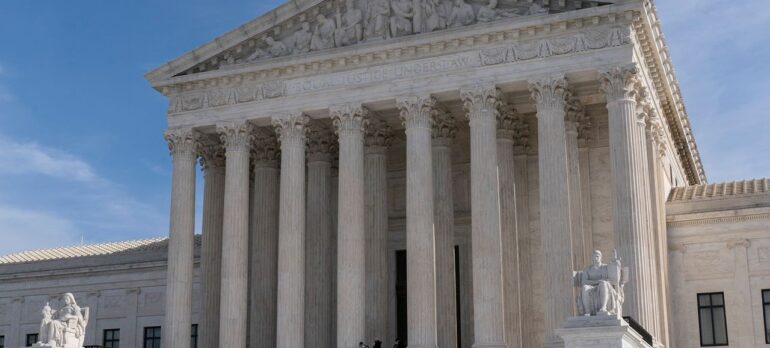
LDF Calls for Clear Redistricting Standards at the U.S. Supreme Court
On Monday, May 2, 2022, Lawyers Democracy Fund (LDF) filed an amicus brief at United States Supreme Court to advocate for clear legal standards for redistricting maps in Merrill v. Milligan, consolidated with Merrill v. Caster.
The issue before the United States Supreme Court is whether the State of Alabama’s 2021 redistricting plan for its seven seats in the United States House of Representatives violated section 2 of the Voting Rights Act. The Supreme Court temporarily upheld Alabama’s maps in February 2022 after it granted a motion to stay the District Court’s opinion, which struck down Alabama’s redistricting map. Certiorari was granted to hear the case on the merits, and oral arguments have yet to be set.
The redistricting process is due for some updated standards to help avoid the incessant litigation that occurs every 10 years as states roll out their new congressional maps. In its brief, LDF highlighted the dilemma states face in the redistricting process as they attempt to comply with both Section 2 of the Voting Rights Act, which requires the consideration of race in the redistricting process, and the Equal Protection Clause of the 14th Amendment, which restricts the use of race.
The need for clarity in the application of the Voting Rights Act to the decennial redistricting process is profoundly important. Redistricting authorities throughout our Nation need a clear legal standard to appropriately navigate the “competing hazards of liability,” Bethune-Hill v. Virginia State Bd. of Elections, 137 S. Ct. 788, 802 (2017), occasioned by the Voting Rights Act’s requirement to consider race in redistricting, on one hand, and the limitations on the use of race compelled by the Fourteenth Amendment’s Equal Protection Clause, on the other. That certainty also inspires public confidence in the electoral process and the rule of law.
This legal regime requires states to minimize the use of race in redistricting to comply with the Fourteenth Amendment, while simultaneously considering race where necessary to avoid minority vote-dilution under Section 2 of the Voting Rights Act.
A jurisdiction can be found liable under Section 2 if does not consider race enough, i.e., by failing to draw a majority-minority district where one is necessary to assure minority voters an equal opportunity to elect their preferred candidates. But on the other hand, a jurisdiction that considers race too much in its redistricting, i.e., one that draws a race-based district beyond that needed to comply with Section 2, can find its plan struck down as a racial-gerrymander in violation of the Equal Protection Clause.
Having clear guidance on how to balance these delicate, and often competing goals, is essential to guide the conduct of states and localities, political actors, courts, and the public. The district court decision adds confusion, rather than clarity, to the law.
LDF advocated for the Supreme Court to issue clear and meaningful standards that states can use in the redistricting process going forward to avoid unnecessary litigation.
Having clear guidance on how to balance these delicate, and often competing goals, is essential to guide the conduct of states and localities, political actors, courts, and the public.
Navigating these competing hazards of liability requires clear, workable standards for when Section 2 requires the consideration of race in redistricting. The district court’s decision fails to offer such standards, and if allowed to stand will only exacerbate the expense, disruption, and legal risk facing the redistricting process. Legislatures, lower courts, and the public would be better served with a clear, administrable standard for determining the benchmark “undiluted” plan to use to judge a Section 2 vote-dilution claim, and Amicus urges the Court to adopt one.
The Court should affirm that for a district to be compact and reasonably configured, it must follow traditional districting principles such as maintaining communities of interest and traditional boundaries. Doing so honors the important doctrinal, historical, and policy reasons behind district-based representation…Requirements that preserve political subdivisions serve independent values, including facilitation of political organization, electoral campaigning, and constituent representation. Subordinating traditional districting principles to race, and thereby creating a § 2 “district” that departs from the traditional common understanding of a district, would risk depriving those voters of these benefits of traditional districting.
Lawyers Democracy Fund respectfully requests that this Court reverse the district court’s decision below, and provide state legislatures a clear legal standard for discharging their responsibilities under the Fourteenth Amendment and Section 2 of the Voting Rights Act.
To read LDF’s amicus brief in its entirety, click here.
LDF filed an amicus brief at #SCOTUS in support of clear legal standards for #redistricting maps in Merrill v. Mulligan, consolidated with Merrill v. Caster. Here are LDF’s main arguments: https://t.co/xgiFgDCNPG 🧵 1/11
— Center for Election Confidence (@voterconfidence) May 3, 2022

